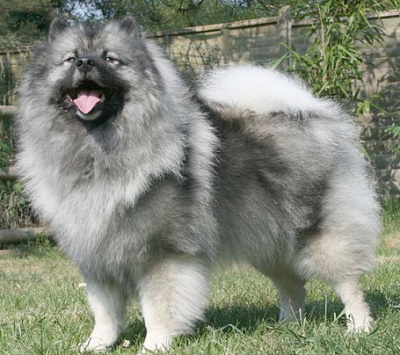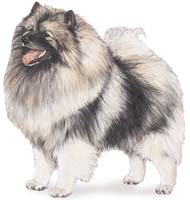Keeshond Dogs
They Need Strong Leaders!
Keeshond dogs originated from nordic ancestors - or more specifically the German Wolfspitz. This old breed is well-known in many parts of Europe, but is especially associated with Holland due to its symbolic link with the Dutch Patriot party and the political events occurring in that country during the 18th century.

Subsequently when that party fell out of favor, so did the popularity of the breed. Interest in the Kees
was rekindled in Holland around 1920.
Early in its history, the Keeshond mainly lived his life as a
companion/watchdog on farms, river boats and barges which undoubtedly is
the
reason he also became known as the Dutch Barge Dog. He also earned a
reputation as a skillful dispatcher of vermin.
Keeshond dogs have a keen facial expression with a bespectacled look
around the eyes.
In stature they are a medium-sized dog standing 17 to 19 inches to the withers, well-balanced and compactly built.
With respect to the breed's weight range, there are differing opinions, some sources indicating 35 to 45 pounds while others cite a range of 55 to 66 pounds.
Characteristics of Keeshond Dogs
Keeshond dogs are known for their high intelligence and love of family. They most definitely are a breed that likes to stay in
close contact with their "pack" and should not be kept outside. To keep them apart from family would be unkind and eventually
lead to troublesome behaviors.
They are very alert, protective and natural watchdogs. As is the case with most smart dogs, they need strong leaders and no
ambiguity about who's in charge. But being quick learners, an owner who trains with consistency and fairness will
reap the rewards of a very enjoyable companion.
The Keeshond dog breed has achieved considerable success in agility and
obedience events so this is a good area to consider for training which will also put you in the alpha position and give
them the structure they need.
On another note, although this dog breed is very friendly, some can be timid. For this reason, it's a good idea to socialize
them early in life to build their confidence with other people and a variety of situations.
The Keeshond has a loud distinctive bark, but is not aggressive toward
those his owner welcomes. He uses his bark to warn of
approaching visitors, but will not generally become a nuisance barker
unless he is isolated for long periods and cut off from companionship.
Keeshond dogs that are well-nourished and cared for, can be expected to live between 12 to 15 years.

Grooming
Keeshond dogs have a lush double coat that is especially profuse around the ruff, hind quarters and tail. The outercoat combines a mixture of cream, gray, and black, with black being the transition color on the tips of the hair.
By contrast, the
undercoat is quite pale and is seen in much lighter shades of gray or
cream. According to the kennel club standard the undercoat should never
be tawny.
This breed has heavy seasonal shedding. In between these periods, regular brushing is needed to remove
the build-up of dead hair. Very popular grooming tools for this job are the FURminator
and the ZoomGroom. For big shedders, these two together are awesome!
The Kees normally does not need frequent bathing as they do not have any significant canine odor about them.
How Active is the Keeshond?
The Keeshonds are rambunctious and energetic dogs that love to run and play. They need to be taken out for
brisk long walks every day. A fitness treadmill for dogs is a good alternate workout when when other activities are not available.
Given the opportunity, they also love the water and are known for their
swimming abilities.
Ideal Living Space
A house with yard is the ideal. Shade needs to be available when playing outside in warm weather.
His abundant overcoat makes him not so tolerant of the heat. Air conditioning would be a plus for dog houses in extra warm climates.
The Keeshond And Children?
This breed has a reputation for being especially fond of children, but seems to do best with older children rather than toddlers.
As always, adult supervision is recommended whenever children and pets interact, no matter what the breed.
Seniors Or Sedentary Families?
Keeshond dogs are known to be very sensitive toward humans and have been
used in therapy situations. They develop strong attachments
to their masters and are very protective.
These special traits makes "mature" Kees a good breed for senior owners to consider, providing
their exercise needs can be met.
A dog walker is always an option for more sedentary families.
Share Your Keeshond Knowledge
- Do you own a Keeshond dog or have previously owned one?
- Would you like to share what you know about the breed?
- Or, is this breed just one of your favorites and you'd like to make some comments about this interesting dog?
We invite any and all dog lovers to make a post about this breed, or their favorite breed and we'll publish your
comments on a webpage along for others to enjoy. We'll even add your name if you'd like the recognition.
Visit this page where you'll find a
text box to post your comments. You'll also be able to read stories that others have written about their favorite
dogs.
Go on, give it a try!
Further Reading

A detailed guide for new or experienced owners. Provides information about the characteristics, care and history of the breed.
Includes helpful guidance about locating a
good breeder, preparing to meet them and the puppies, as well
as a wealth of information about puppy care.

